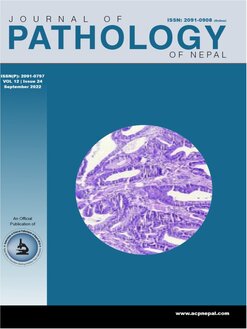Ambiguity in pathology reporting: Our intent versus their interpretation!
Keywords:
Ambiguity, Pathology reportingAbstract
Ambiguity is the quality of being open to more than one interpretation. We, pathologists, use ambiguous terms such as “suspicious for, indefinite for, cannot rule out, consistent with, compatible with, in keeping with, raises possibility of, suggestive of, favors” to express varying degrees of certainty in our diagnosis. The embracement of such terminologies is a common practice and could be attributed to a lack of absolute diagnostic certainty or owing to ritualistic caution to avoid liability risk. Studies from US showed that ambiguous terminologies were used in 35% of their reports1 and 17.7% of the pathologists reported using it more than often (≥ 50%)2. In the Nepalese context, where access to immunohistochemistry is limited and sense of superspecialization is just emerging, this percentage can be expected to be higher.
We optimistically assume that clinicians perceive these terminologies as analogous to what we want to convey. However, discordance is observed between the pathologist’s intent and the clinician’s interpretation.1,3,4 In a survey, “favors” was assigned median diagnostic certainty of 35.3% by pathologists and 60.3% by clinicians, and the difference was statistically significant.2 Existence of inter-observer variability even between pathologists adds to the concern.1 For instance, the probability associated with the term “in keeping with” ranged from 25 to 100% among pathologists.4 This inconsistency stems from the unavailability of standard guidelines on phraseology in pathology reporting.
Nakao et al recommends the usage of numerical rather than verbal descriptions of certainty.5 Assigning an exact number to words feels controversial as it may provide a false sense of confidence in scenarios where the level of certainty is uncertain. A “standardized scheme for reporting certainty in pathology reports” was introduced by Amin et al. The ambiguous terms were assigned numerical certainty levels with accompanying recommendations including whether or not a definite treatment should be offered.2
We need to be aware of the possible implications related to ambiguous reporting on patient management. Adopting a culture of peer reviewing can boost our diagnostic certainty and limit linguistic ambiguity in reporting. Direct communication with our clinical colleagues can bring about homogeneity in our understanding of ambiguous terminologies. Development of regional guidelines defining commonly used ambiguous terms, their range of diagnostic certainty, and recommendations to clinicians can prevent us and our reports from being misunderstood.
Let our reports be clear and comprehensible. Let us not resonate, in the matter of Pathology reporting, with Italian film director Bernando Bertolucci who quoted “I left the ending ambiguous because that is the way life is”.
Downloads
Downloads
Published
How to Cite
Issue
Section
License
Copyright (c) 2022 Palzum Sherpa

This work is licensed under a Creative Commons Attribution 4.0 International License.
This license enables reusers to distribute, remix, adapt, and build upon the material in any medium or format, so long as attribution is given to the creator. The license allows for commercial use.




